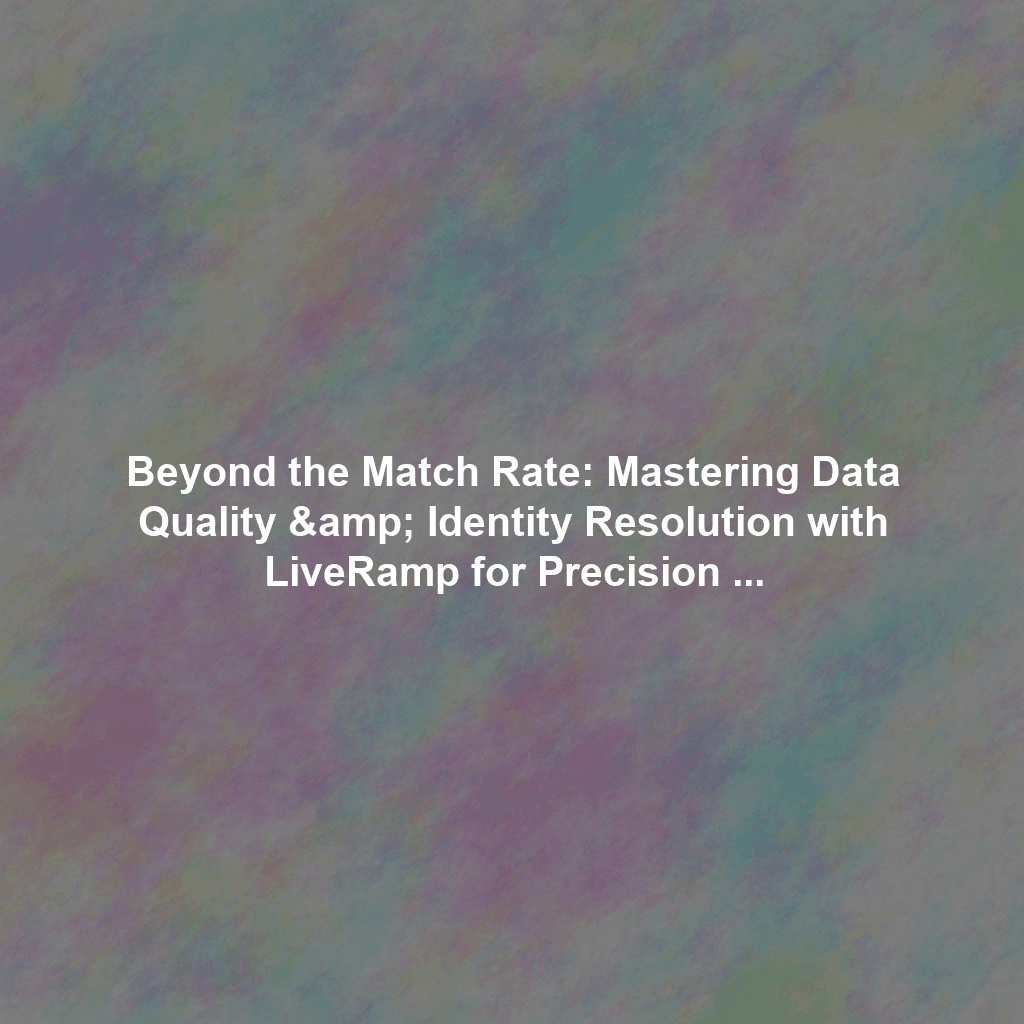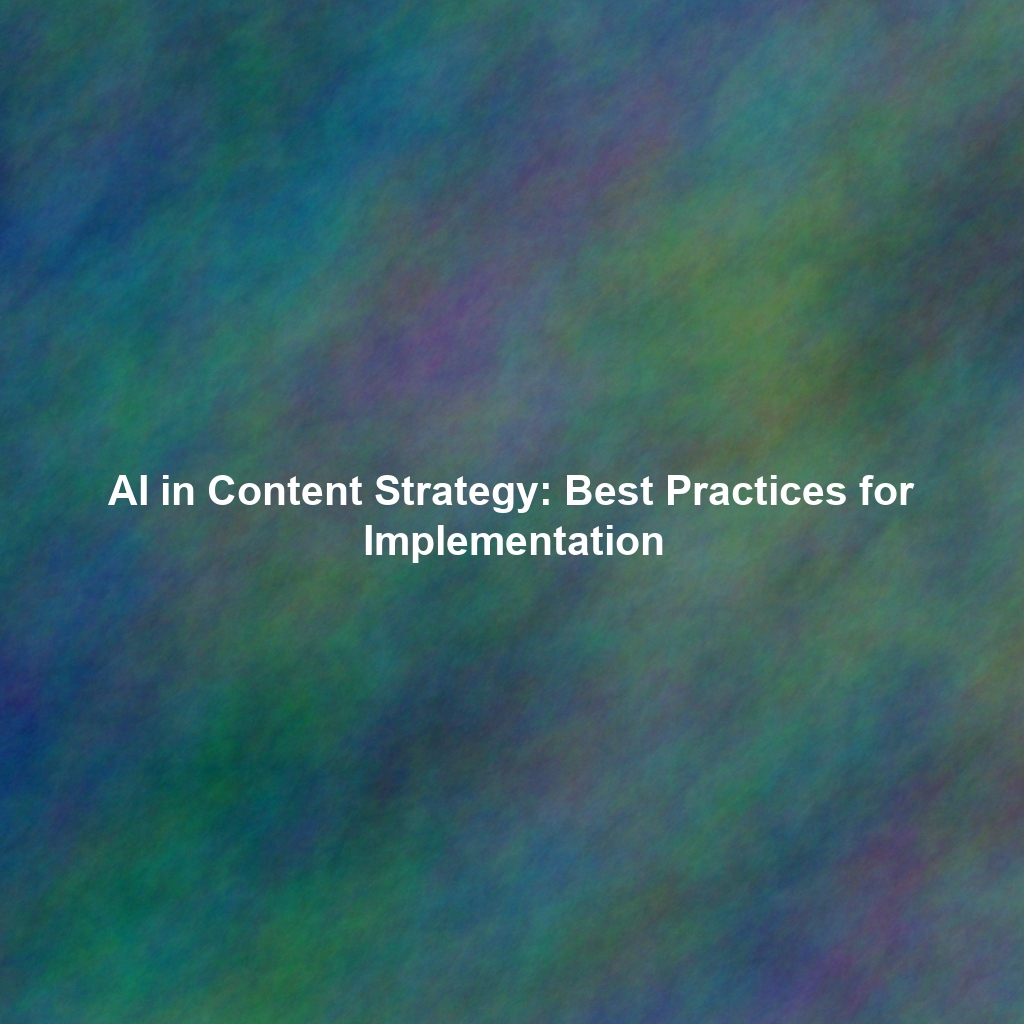The Critical Imperative of Data Quality in LiveRamp: Beyond Vanity Metrics
Match rates are a valuable initial metric, indicating the percentage of your offline customer data that LiveRamp can successfully match to digital identities within its vast ecosystem (the IdentityLink graph). However, a high match rate, in isolation, doesn’t guarantee high-quality, actionable data. This is a crucial distinction. Dirty data, inaccurate identifiers, outdated information, or incomplete profiles can still lead to significant wasted ad spend, ineffective targeting, flawed personalization, and ultimately, suboptimal campaign performance. Therefore, prioritizing **data quality** is paramount, not just as a pre-onboarding step, but as a continuous, end-to-end process.
The Strategic Limitations of Match Rates as a Sole Metric:
Relying solely on match rates can be profoundly misleading and lead to flawed strategic decisions because:
- Match rates don’t reflect data accuracy: A matched record might contain outdated, incorrect, or conflicting information (e.g., an old address, a misspelled name). Matching inaccurate data simply propagates the inaccuracy.
- Match rates don’t account for profile completeness: Even if a record successfully matches to an identity, crucial attributes necessary for rich segmentation or personalization (e.g., age, gender, interests, purchase history) may be missing, limiting its utility.
- Match rates can be inflated by low-quality data: Inaccurate or ambiguous data may inadvertently “match” to the wrong identities, artificially boosting the reported match rate while leading to mis-targeted campaigns and negative customer experiences. This is a dangerous form of “garbage in, garbage out.”
- Match rates don’t guarantee actionability: A matched identity is only valuable if it can be activated for specific marketing purposes (e.g., targeting on a particular ad platform). The ability to activate that identity for a specific use case is the true measure of value.
The Cost of Bad Data: A Hidden Expense
Poor data quality leads to significant hidden costs: wasted ad impressions, irrelevant messaging, frustrated customers, inaccurate analytics, and flawed strategic decisions. Investing in data hygiene isn’t an expense; it’s a direct investment in marketing efficiency and customer experience.
Data Hygiene Best Practices for LiveRamp Success: Engineering Clean Data
Implementing robust, continuous data hygiene practices is absolutely crucial for maximizing the value of your LiveRamp investment and ensuring your data is accurate, consistent, and truly ready for high-precision activation. This is a foundational step for any data-driven marketing strategy.
1. Standardization and Normalization: Creating Uniformity
Inconsistent data formats across different source systems can severely hinder matching processes and create inaccurate, fragmented customer profiles. Standardizing and normalizing your data involves transforming it into a consistent, uniform format:
- Address Standardization: Use a consistent address format, ideally adhering to national postal service standards (e.g., USPS standards for the US, Royal Mail for the UK). This includes proper abbreviations, capitalization, and formatting of street names, cities, and postal codes.
- Name Normalization: Correct variations in names (e.g., “Robert,” “Rob,” “Bob”; “Catherine,” “Cathy”). This can involve standardizing to full names or preferred names, and handling common misspellings.
- Phone Number Formatting: Ensure all phone numbers adhere to a standard, consistent format (e.g., E.164 international format, or a consistent national format with area codes). Remove extraneous characters.
- Email Normalization: Standardize email addresses to lowercase, remove leading/trailing spaces, and handle common typos (e.g., “gmail.com” vs. “googlemail.com”).
- Date & Time Formatting: Ensure consistent date and time formats across all data sources.
2. Data Deduplication: Eliminating Redundancy for a Single Customer View
Duplicate records are a pervasive problem that can skew your data, lead to inefficient targeting (e.g., sending the same ad to the same person multiple times), and waste ad spend. Implement a rigorous deduplication process to identify and remove redundant entries, creating a single, authoritative customer record:
- Exact Matching: Identify and merge records that are identical across key identifiers (e.g., exact match on email address AND phone number).
- Fuzzy Matching & Probabilistic Algorithms: Use sophisticated algorithms to identify records that are similar but not identical (e.g., slight variations in name or address). LiveRamp’s identity resolution capabilities can assist here by linking these “fuzzy” matches.
- Rule-Based Deduplication: Define custom rules based on a hierarchy of key identifiers (e.g., “if email address matches, consider it a duplicate, regardless of other fields”).
- Survivorship Rules: When merging duplicates, define rules for which data fields “win” (e.g., always keep the most recent address, or the most complete phone number).
3. Data Appending and Enrichment: Building Richer Customer Profiles
Enhance the depth and utility of your existing customer data by appending missing information and enriching profiles with valuable additional attributes. This creates a more comprehensive view of your customer, enabling more precise segmentation and personalization:
- Third-Party Data Enrichment: Partner with reputable data providers (often through LiveRamp’s ecosystem) to append demographic, behavioral, lifestyle, and interest data to your customer profiles. This can include household income, presence of children, hobbies, or brand affinities.
- Reverse Appending: Match existing identifiers (e.g., email addresses, phone numbers) to fill in missing information like postal addresses, or vice-versa, to create a more complete identity graph.
- Behavioral Data Integration: Continuously integrate behavioral data from your website (page views, clicks), app usage, and marketing interactions into customer profiles.
- Transactional Data Integration: Link purchase history, order values, product categories, and frequency of purchase to customer profiles for powerful segmentation and personalization.
Optimizing Identity Resolution Strategies within LiveRamp: The Power of the Identity Graph
LiveRamp’s core strength lies in its ability to build and leverage a sophisticated identity graph. This graph connects various online and offline identifiers (e.g., email addresses, phone numbers, postal addresses, device IDs, cookie IDs) to create a unified, persistent view of each customer across disparate touchpoints. Optimizing your identity resolution strategy involves understanding how LiveRamp builds its graph and strategically leveraging its capabilities to improve accuracy, reach, and activation potential.
Strategic Approaches to Identity Resolution:
- Leveraging Multiple Identifiers: Don’t rely solely on one identifier (e.g., email address) for matching. Incorporating a comprehensive set of multiple high-quality identifiers (e.g., hashed email, hashed phone number, postal address, first name, last name, device IDs, loyalty program IDs) significantly strengthens the identity graph, improves matching accuracy, and increases the overall match rate. The more unique, high-quality identifiers you provide, the better LiveRamp can resolve identities.
- Understanding LiveRamp’s Identity Graph Logic: Familiarize yourself with how LiveRamp’s proprietary IdentityLink graph links various identifiers and resolves potential conflicts or ambiguities. LiveRamp uses a combination of deterministic matching (based on exact matches of unique identifiers) and probabilistic matching (based on statistical likelihood when exact matches aren’t available). This understanding will help you troubleshoot matching issues, interpret match rates, and optimize your data onboarding process.
- Implementing Persistent Identifiers (First-Party IDs): Persistent identifiers from your internal systems (e.g., CRM IDs, loyalty program IDs, customer account numbers) provide a stable and reliable way to link customer data across different internal systems and channels. By onboarding these first-party IDs to LiveRamp, you create a robust, privacy-safe bridge between your internal customer view and LiveRamp’s digital identity graph, improving identity resolution accuracy and allowing for more consistent customer experiences.
- Regular Identity Graph Audits: Periodically audit the quality and completeness of the identities resolved within LiveRamp. Look for potential discrepancies, gaps, or areas where additional data sources could enhance the graph’s robustness.
- Privacy-Enhancing Technologies (PETs): LiveRamp is built on a foundation of privacy. Understand and leverage its PETs, such as hashing and encryption, to ensure that customer data is pseudonymized and protected throughout the onboarding and activation process, maintaining compliance with privacy regulations (e.g., GDPR, CCPA).
Anecdote: The Retailer’s Unified Customer View
A large apparel retailer struggled with fragmented customer data across its e-commerce platform, loyalty program, and in-store POS system. Their marketing efforts were siloed and inefficient. By implementing LiveRamp and meticulously cleaning, standardizing, and onboarding data from all three sources, they achieved a unified customer view. This allowed them to identify that a customer who purchased online was the same individual who used their loyalty card in-store. With this unified identity, they could personalize email offers based on in-store purchases and retarget online shoppers with relevant in-store promotions, resulting in a 12% increase in cross-channel conversion rates and a 7% reduction in wasted ad spend due to duplicate targeting. “We finally saw our customers as individuals, not just data points,” their Head of Data Strategy noted. “That clarity was transformative.”
Measuring and Improving Data Completeness: Fueling Precision Marketing
Beyond match rates and accuracy, **data completeness** is paramount for effective segmentation, targeting, and personalization. A record might be accurate and matched, but if it lacks key attributes like age, gender, or specific interests, its utility for sophisticated marketing campaigns is severely limited. Track the percentage of profiles with complete information for critical attributes and implement continuous strategies to improve data completeness.
Strategies for Enhancing Data Completeness:
- Regular Data Completeness Audits: Implement a routine process to audit your customer data for completeness. Identify key attributes that are frequently missing and prioritize efforts to fill those gaps. Tools within LiveRamp or external data quality platforms can assist with this.
- Strategic Data Collection at Every Touchpoint: Design your data collection processes (e.g., website forms, app sign-ups, surveys, in-store interactions) to strategically capture the information you need for effective marketing. This may involve updating your forms to include optional but valuable fields, or integrating data from customer service interactions.
- Progressive Profiling: Instead of overwhelming users by asking for all information upfront, use progressive profiling. Gradually collect additional data over time through subsequent interactions (e.g., asking for preferences after a first purchase, or interests after a certain level of engagement). This improves response rates and builds a more complete picture of your customers over their lifecycle.
- Leverage Zero-Party Data: Actively ask customers for their preferences, interests, and intentions directly. This “zero-party data” (data intentionally and proactively shared by the customer) is incredibly valuable and highly accurate for personalization.
- Third-Party Data Appending: As mentioned previously, partner with data providers (often facilitated by LiveRamp) to append missing demographic, lifestyle, or behavioral attributes to your existing customer profiles.
- Data Governance & Ownership: Establish clear data governance policies that define data ownership, data quality standards, and processes for data entry and maintenance across all departments. This ensures ongoing data integrity.
Common Pitfalls to Avoid: Ensuring Optimal LiveRamp Performance
While LiveRamp is a powerful platform, several common pitfalls can hinder your data quality and identity resolution efforts, leading to suboptimal campaign performance. Avoiding these is critical for maximizing your investment:
- Neglecting Pre-Onboarding Data Hygiene: Attempting to onboard dirty, inconsistent, or unstandardized data. LiveRamp can do a lot, but it’s not a magic wand for fundamentally flawed data. Clean your data *before* you send it.
- Relying on a Single Identifier: Only providing email addresses or only phone numbers. The more high-quality identifiers you provide, the better LiveRamp’s matching capabilities.
- Ignoring Data Completeness: Focusing solely on match rates without ensuring that matched profiles contain sufficient attributes for meaningful segmentation and personalization.
- Infrequent Data Onboarding: Not updating your customer data frequently enough. Customer data is dynamic; it needs regular refreshing to remain accurate and relevant.
- Lack of Internal Data Governance: Failing to establish clear internal processes and responsibilities for data collection, entry, and maintenance across departments. Inconsistent internal data sources will always undermine external efforts.
- Underestimating Privacy & Compliance: Not fully understanding or complying with data privacy regulations (GDPR, CCPA) throughout the data lifecycle. This can lead to severe penalties and reputational damage.
- Failing to Measure Beyond Match Rate: Not tracking the downstream impact of data quality on campaign performance (e.g., conversion rates, ad spend efficiency, customer satisfaction).
- Not Leveraging LiveRamp’s Full Capabilities: Using LiveRamp merely as a data pipe without exploring its advanced identity resolution, audience segmentation, or measurement features.
The Future of Identity & Data Quality: Beyond 2025
The landscape of identity resolution and data quality is continuously evolving, driven by privacy regulations, technological advancements, and the deprecation of third-party cookies. Brands must anticipate future trends to maintain a competitive edge:
- Increased Reliance on First-Party Data: With the decline of third-party cookies, the importance of collecting, managing, and activating high-quality first-party customer data will become paramount. LiveRamp’s role in enriching and activating this data will grow.
- Enhanced Privacy-Enhancing Technologies (PETs): Expect further innovation in PETs that allow for data collaboration and activation while maintaining stringent privacy standards.
- AI-Driven Data Quality & Governance: AI and machine learning will play an increasingly sophisticated role in automating data hygiene, identifying data anomalies, predicting data decay, and enforcing data governance policies at scale.
- Cross-Channel Identity Graphs: The need for unified identity graphs that seamlessly connect online and offline, known and unknown customer touchpoints across all channels will intensify.
- Interoperability & Data Clean Rooms: The industry will move towards greater interoperability between platforms and increased use of data clean rooms, allowing brands to collaborate on data insights in a privacy-safe environment without direct data sharing.
Staying ahead in this evolving environment requires continuous investment in data infrastructure, a proactive approach to data quality, and a deep understanding of identity resolution technologies.
Conclusion: Building a Foundation of Trust & Precision with LiveRamp
While match rates provide a starting point for evaluating your LiveRamp data onboarding process, true success and sustainable competitive advantage lie in a holistic commitment to data quality, optimizing identity resolution strategies, and ensuring data completeness. By implementing the rigorous best practices outlined in this article, you can unlock the full, transformative potential of LiveRamp, dramatically improve the accuracy and effectiveness of your marketing campaigns, and deliver more personalized, relevant, and engaging experiences to your customers. Remember to continually monitor your data quality metrics, adapt your strategies as needed, and prioritize privacy to stay ahead in the ever-evolving data landscape. Focusing beyond the initial match rate and investing in robust data management practices will undoubtedly yield higher marketing efficiency, more meaningful customer interactions, and ultimately, a stronger, more resilient business.
 Skip to content
Skip to content

